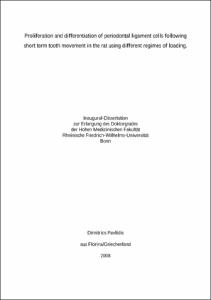Online-Ausgabe in bonndoc: https://nbn-resolving.org/urn:nbn:de:hbz:5M-15892
urn: https://nbn-resolving.org/urn:nbn:de:hbz:5M-15892,
author = {{Dimitrios Pavlidis}},
title = {Proliferation and differentiation of periodontal ligament cells following short term tooth movement in the rat using different regimes of loading},
school = {Rheinische Friedrich-Wilhelms-Universität Bonn},
year = 2008,
note = {
Previous studies have indicated that periodontal ligament cells demonstrate osteogenic potential and osteoblastic differentiation via the ERK pathway under mechanical stress in vitro and in vivo. This study aimed to further analyse this regulatory process experimentally in the rat.
The right upper first molars of 25 anesthetised rats were loaded with forces in order to be moved mesially. Constant forces for 4 hours of 0.25 N and 0.5 N were applied in 5 animals each. Furthermore, constant forces for 2 hours of 0.1 N were applied in 10 animals and afterwards, the first and second molars were permanently separated with composite. In these animals, the antagonists were sliced and five rats were killed after 1 day and five ones after 2 days. At last, intermittent forces of 0.1 N and O.25 Hz were applied in 5 different animals for 4 hours. Untreated contralateral sides served as control. Parafin-embedded sections were analyzed quantitatively after immunohistochemistry for proliferating cell nuclear antigen (PCNA), runt-related transcription factor 2 (Runx2/Cbfa1) and phosphorylated extracellular signal-regulated kinase 1/2 (pERK1/2).
In selected areas under tension the proportion of pERK1/2 positive cells was increased compared with those in control teeth in all types of loading, whereas these proportions in selected areas under pressure were increased only after the application of intermittent forces. In representative areas, both, under tension and pressure the proportion of Runx2 positive cells decreased after the application of constant forces. After the application of constant forces for 4 hours in representative areas, both under tension and pressure the proportion of PCNA positive cells was lower than that in control teeth.
The involvement of pERK1/2, Runx2/cbfa-1 and PCNA in the reaction of periodontal ligament cells to different load regimes was verified.
url = {https://hdl.handle.net/20.500.11811/3808}
}






